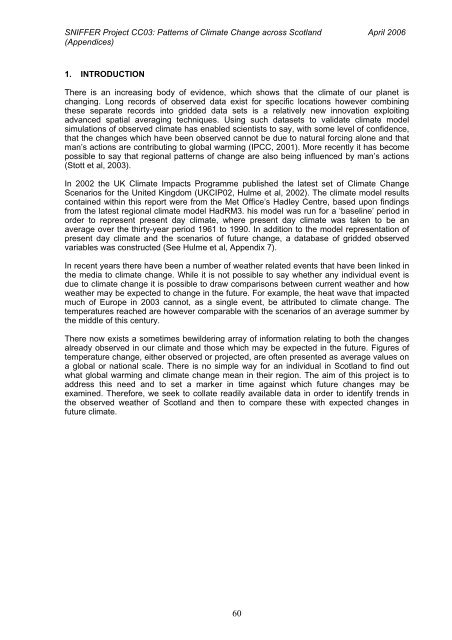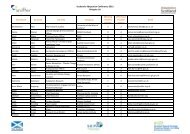Patterns of climate change across Scotland: technical report - Sniffer
Patterns of climate change across Scotland: technical report - Sniffer
Patterns of climate change across Scotland: technical report - Sniffer
Create successful ePaper yourself
Turn your PDF publications into a flip-book with our unique Google optimized e-Paper software.
SNIFFER Project CC03: <strong>Patterns</strong> <strong>of</strong> Climate Change <strong>across</strong> <strong>Scotland</strong> April 2006<br />
(Appendices)<br />
1. INTRODUCTION<br />
There is an increasing body <strong>of</strong> evidence, which shows that the <strong>climate</strong> <strong>of</strong> our planet is<br />
changing. Long records <strong>of</strong> observed data exist for specific locations however combining<br />
these separate records into gridded data sets is a relatively new innovation exploiting<br />
advanced spatial averaging techniques. Using such datasets to validate <strong>climate</strong> model<br />
simulations <strong>of</strong> observed <strong>climate</strong> has enabled scientists to say, with some level <strong>of</strong> confidence,<br />
that the <strong>change</strong>s which have been observed cannot be due to natural forcing alone and that<br />
man’s actions are contributing to global warming (IPCC, 2001). More recently it has become<br />
possible to say that regional patterns <strong>of</strong> <strong>change</strong> are also being influenced by man’s actions<br />
(Stott et al, 2003).<br />
In 2002 the UK Climate Impacts Programme published the latest set <strong>of</strong> Climate Change<br />
Scenarios for the United Kingdom (UKCIP02, Hulme et al, 2002). The <strong>climate</strong> model results<br />
contained within this <strong>report</strong> were from the Met Office’s Hadley Centre, based upon findings<br />
from the latest regional <strong>climate</strong> model HadRM3. his model was run for a ‘baseline’ period in<br />
order to represent present day <strong>climate</strong>, where present day <strong>climate</strong> was taken to be an<br />
average over the thirty-year period 1961 to 1990. In addition to the model representation <strong>of</strong><br />
present day <strong>climate</strong> and the scenarios <strong>of</strong> future <strong>change</strong>, a database <strong>of</strong> gridded observed<br />
variables was constructed (See Hulme et al, Appendix 7).<br />
In recent years there have been a number <strong>of</strong> weather related events that have been linked in<br />
the media to <strong>climate</strong> <strong>change</strong>. While it is not possible to say whether any individual event is<br />
due to <strong>climate</strong> <strong>change</strong> it is possible to draw comparisons between current weather and how<br />
weather may be expected to <strong>change</strong> in the future. For example, the heat wave that impacted<br />
much <strong>of</strong> Europe in 2003 cannot, as a single event, be attributed to <strong>climate</strong> <strong>change</strong>. The<br />
temperatures reached are however comparable with the scenarios <strong>of</strong> an average summer by<br />
the middle <strong>of</strong> this century.<br />
There now exists a sometimes bewildering array <strong>of</strong> information relating to both the <strong>change</strong>s<br />
already observed in our <strong>climate</strong> and those which may be expected in the future. Figures <strong>of</strong><br />
temperature <strong>change</strong>, either observed or projected, are <strong>of</strong>ten presented as average values on<br />
a global or national scale. There is no simple way for an individual in <strong>Scotland</strong> to find out<br />
what global warming and <strong>climate</strong> <strong>change</strong> mean in their region. The aim <strong>of</strong> this project is to<br />
address this need and to set a marker in time against which future <strong>change</strong>s may be<br />
examined. Therefore, we seek to collate readily available data in order to identify trends in<br />
the observed weather <strong>of</strong> <strong>Scotland</strong> and then to compare these with expected <strong>change</strong>s in<br />
future <strong>climate</strong>.<br />
60



